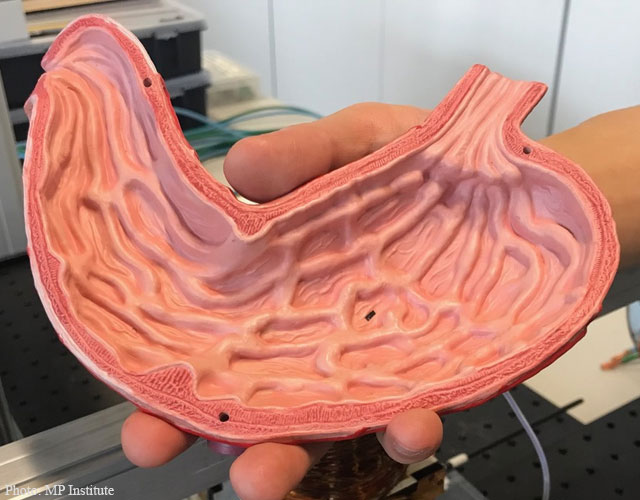Scientists at the Max Planck Institute for Intelligent Systems in Stuttgart, Germany have developed a tiny elastic robot that could one day be able to patrol the human body from the inside.
Describing their invention in the journal Nature, the German researchers explain that the four millimeters long magneto-elastic soft robot has the ability to walk, jump, crawl and roll. It even swims upwards when completely immersed and climbs out of the pool, moving seamlessly from a watery environment into a dry one.
The bot’s creators say they were inspired by the movements of soft-bodied beetle larvae and caterpillars. Jellyfishes also lent some of their traits to the little creature which according to Dr. Metin Sitti, head of the physical intelligence department at the Max Planck Institute, is a “minimalist robot” that can achieve “all different type of motion possibilities to navigate in complex environments.”
“In the future, our robot can carry drugs and deliver them to a desired location where they are most needed, much like a doorstep delivery”, Sitti said in a press release, noting that the bot would be “delivered through swallowing or a cavity on the skin and make its way through the digestive or urinary tract, abdominal cavity, or heart surface.”
Obviously, the first question when it comes to Sitti’s comments is how can this nature-inspired soft millirobot accomplish such a variety of movements if it doesn’t have any sort of limbs.
According to the scientists, the rectangular-sheet-shaped robot is made out of a soft, pliable rubber that’s embedded with magnetic particles. By using external magnetic fields to put pressure on the magnetic particles, the researchers are able to change and deform the bot’s shape. It’s these physical intelligence methods, the engineers say, that allow the robot to jump over obstacles, carry small cargo, crawl and roll through uneven terrain, and more.
The scientists are still in the testing phase of the project. So far, the robot has been tested within a synthetic surgical stomach model and chicken tissue.
“Currently it is not possible to access many small regions inside the human body without surgery, but our target is to reach such regions non-invasively and conduct diagnostic and therapeutic operations with our soft robots,” Sitti envisions.
For many, the idea of having a robot crawling inside your abdomen might make people unconfortable.
But the study notes that the robot can be located using medical imaging devices: “We also show that the robot can be visualized by an ultrasound medical imaging device as it rolls within the concealed areas of an ex vivo chicken muscle tissue.”
In an interview with the New York Times, Sitti said that he is already thinking about making the robot smaller, in addition to including a small pocket on it that only opens with a special shape change.
Sitti also said that his research team is working on creating a fully biodegradable version of the bot that can be dissolved inside the body without causing any side effects.
‘That’s one of our major goals in my group,’ Sitti was quoted as saying by the Times. ‘And that’s possible.’
Reference: MP Institute
- Bulenox: Get 45% to 91% OFF ... Use Discount Code: UNO
- Risk Our Money Not Yours | Get 50% to 90% OFF ... Use Discount Code: MMBVBKSM
Disclaimer: This page contains affiliate links. If you choose to make a purchase after clicking a link, we may receive a commission at no additional cost to you. Thank you for your support!


Leave a Reply